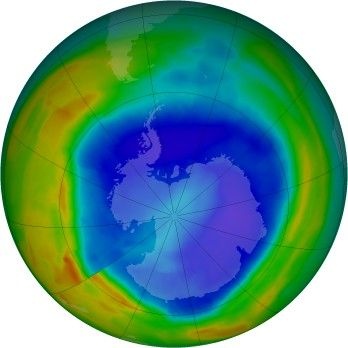 The ozone layer appears to be continuing on the path to recovery, an international panel of 300 scientists reports today. Atmospheric levels of the chemicals that destroy ozone have now declined by 10–15% since peaking in 2000, a sign of improving health. The current ozone hole over Antarctica is shown here in blue. The current ozone hole over Antarctica is shown here in blue. NASA A report released by a team from the United Nations Environmental Programme (UNEP) and the World Meteorological Organization documents a clear trend of ozone increasing in the upper stratosphere, approximately 42 kilometres high, at a rate of over 3% per decade. The data also suggest that the total amount of ozone in the atmosphere is growing, but they are not yet conclusive. Models estimate that levels of ozone-depleting chemicals will fall to their 1980 levels by 2030, and the total amount of ozone will rebound soon after, preventing an estimated 2 million cases of skin cancer. Ozone-destroying industrial chemicals known as chlorofluorocarbons (CFCs), once widespread in air conditioners and aerosol cans, cause the annual ‘hole’ in the ozone layer that forms every year in the Southern Hemisphere’s spring. CFCs were banned worldwide by the Montreal Protocol in 1987, which was ratified by all UN member nations. However, like CFCs, the chemicals that replaced them — hydrofluorocarbons (HFCs) — are potent greenhouse gases. The report recommends switching to alternatives with less greenhouse potential, such as hydrofluoro-olefins. In fact, ozone levels are linked tightly to climate. The report finds that half of the ozone recovery is due to greenhouse gases’ changing the temperature structure of the atmosphere. By trapping heat in the troposphere, the gases let less heat escape to the stratosphere — and cooler temperatures enable ozone production, explains Steve Montzka, an atmospheric scientist at the US National Oceanic and Atmospheric Administration in Boulder, Colorado. “I think the great message is that if we act now in understanding the connection between ozone and climate action we can avoid a major problem,” said Achim Steiner, UNEP’s executive director. Team members hope that the success of the Montreal Protocol will encourage similar action on the reduction of greenhouse gases. “There is tremendous scope for achieving further changes,” Steiner said.
The ozone layer appears to be continuing on the path to recovery, an international panel of 300 scientists reports today. Atmospheric levels of the chemicals that destroy ozone have now declined by 10–15% since peaking in 2000, a sign of improving health. The current ozone hole over Antarctica is shown here in blue. The current ozone hole over Antarctica is shown here in blue. NASA A report released by a team from the United Nations Environmental Programme (UNEP) and the World Meteorological Organization documents a clear trend of ozone increasing in the upper stratosphere, approximately 42 kilometres high, at a rate of over 3% per decade. The data also suggest that the total amount of ozone in the atmosphere is growing, but they are not yet conclusive. Models estimate that levels of ozone-depleting chemicals will fall to their 1980 levels by 2030, and the total amount of ozone will rebound soon after, preventing an estimated 2 million cases of skin cancer. Ozone-destroying industrial chemicals known as chlorofluorocarbons (CFCs), once widespread in air conditioners and aerosol cans, cause the annual ‘hole’ in the ozone layer that forms every year in the Southern Hemisphere’s spring. CFCs were banned worldwide by the Montreal Protocol in 1987, which was ratified by all UN member nations. However, like CFCs, the chemicals that replaced them — hydrofluorocarbons (HFCs) — are potent greenhouse gases. The report recommends switching to alternatives with less greenhouse potential, such as hydrofluoro-olefins. In fact, ozone levels are linked tightly to climate. The report finds that half of the ozone recovery is due to greenhouse gases’ changing the temperature structure of the atmosphere. By trapping heat in the troposphere, the gases let less heat escape to the stratosphere — and cooler temperatures enable ozone production, explains Steve Montzka, an atmospheric scientist at the US National Oceanic and Atmospheric Administration in Boulder, Colorado. “I think the great message is that if we act now in understanding the connection between ozone and climate action we can avoid a major problem,” said Achim Steiner, UNEP’s executive director. Team members hope that the success of the Montreal Protocol will encourage similar action on the reduction of greenhouse gases. “There is tremendous scope for achieving further changes,” Steiner said.
Ozone recovery helped by warming climate
Posted on at



